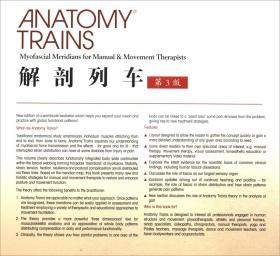
解剖列车(第3版原版影印)
全新正版 快速发货
¥ 90.78 5.0折 ¥ 180 全新
库存3件
天津和平
认证卖家担保交易快速发货售后保障
作者[美]托马斯·梅尔斯(Thomas W.Myers) 编
出版社北京大学医学出版社
出版时间2019-07
版次1
印数1千册
装帧平装
上书时间2024-10-30
- 最新上架
商品详情
- 品相描述:全新
图书标准信息
- 作者 [美]托马斯·梅尔斯(Thomas W.Myers) 编
- 出版社 北京大学医学出版社
- 出版时间 2019-07
- 版次 1
- ISBN 9787565919725
- 定价 180.00元
- 装帧 平装
- 开本 16开
- 纸张 胶版纸
- 页数 317页
- 【内容简介】
-
Since initial publication in 2001, the reach and application of the ideas in this book have far outstripped this author's expectations. We and our staff have been invited to present these ideas and their application on every continent save Antarctica to a wide variety of professionals, including orthopedists, physiotherapists, physiotherapists, chiropractors,osteopaths, psychologists, athletic and personal trainers,performance coaches, yoga teachers, martial artists,massage therapists, dancers, and somatic educators of all stripes. The book is now available in 12 languages. A simple Google~ search of Anatomy Trains now yields nearly 6,000,000 hits, as therapists and educators find useful appli-cations far beyond our original conception.
This third edition includes many small updates and corrections that arose out of our continuing teaching and practice, as well as preliminary evidence from fascial dissections.We have been able to include some recent discoveries made in the fascial and myofascial world since the second edition (much of it summarized in Fascia, the Tensional Network of the Human Body, 2012, Schleip R, Findley T, Chaitow L,Huijing P; Edinburgh: Churchill Livingstone), as well as to fill in areas where our initial ignorance of the wider world has been rectified. - 【目录】
-
Preface
Preface to the first edition
Acknowledgements
Introduction: laying the railbed
1 Fascia and biomechanicalregulation
2 The rules ofthe game
3 The SuperficialBack Line
4 The SuperficiaIFront Line
5 The Lateral Line
6 The Spiral Line
7 The Arm Lines
8 The Functional Lines
9 The Deep Front Line
10 AnatomyTrains in training
With a contribution by James Earls
11 Structuralanalysis
Appendix 1 A note on the meridians oflatitude
A.ppendix2 Structuralintegration
Appendix 3 Myofascial meridians and Asian medicine
Anatomy Trains terms
Bibliography
Index
点击展开
点击收起
相关推荐
— 没有更多了 —


















以下为对购买帮助不大的评价